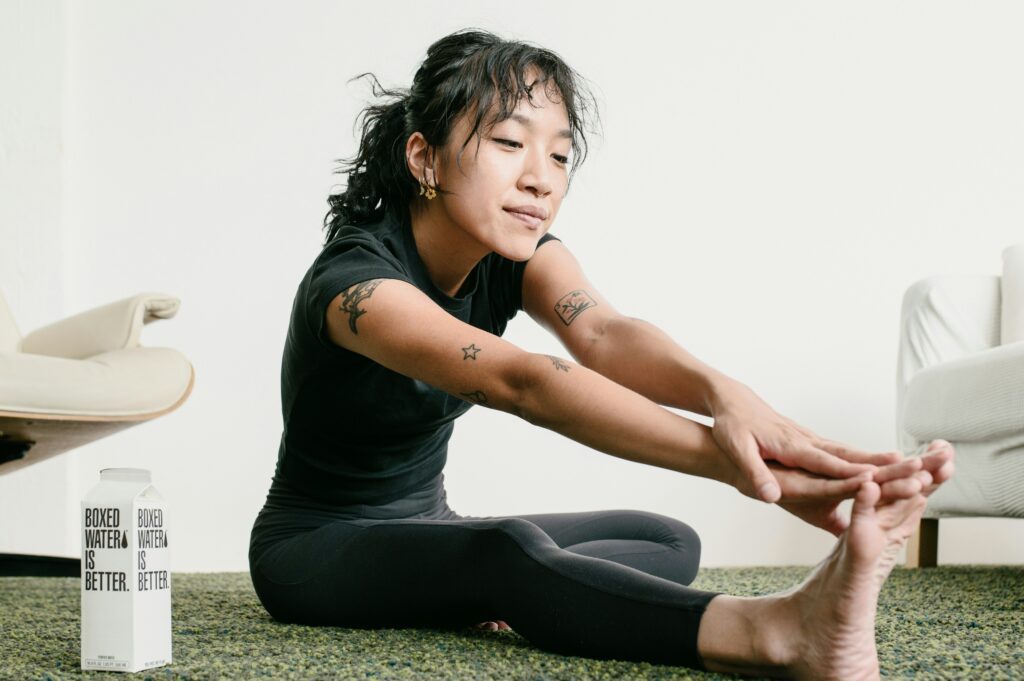If you’ve ever wondered how to craft a physical fitness plan tailored to your own needs and goals, look no further! In “The Ultimate Guide: How to Create a Physical Fitness Plan,” you’ll find all the information and guidance you need to kickstart your fitness journey. Whether you’re a complete beginner or a seasoned gym-goer, this article will provide you with valuable insights and actionable steps to create a plan that is effective, enjoyable, and sustainable. Say goodbye to confusion and hello to a fitter, healthier you!

This image is property of images.unsplash.com.
Setting Goals
Identify your fitness goals
When creating a physical fitness plan, the first step is to identify your fitness goals. What is it that you want to achieve through your workouts? Are you looking to lose weight, build muscle, improve flexibility, or increase endurance? By clarifying your goals, you can effectively tailor your fitness plan to meet your specific needs.
Make your goals SMART (Specific, Measurable, Achievable, Realistic, Time-bound)
To ensure that your fitness goals are effective and attainable, it is essential to make them SMART. Specific goals are clear and concise, such as “lose 10 pounds” or “run a 5K race.” Measurable goals allow you to track your progress over time, such as by setting a target weight or time for completing a certain exercise. Achievable goals are within your capabilities and align with your current fitness level. Realistic goals take into account your lifestyle, available time, and any physical limitations. Time-bound goals have a specific timeline, providing a sense of urgency and motivation. By making your goals SMART, you can increase the likelihood of success in your fitness journey.
Assessing Fitness Level
Consult with a healthcare professional
Before embarking on any fitness program, it is crucial to consult with a healthcare professional, especially if you have any pre-existing medical conditions or concerns. A healthcare professional can provide valuable guidance, assess your overall health, and help determine any specific precautions or modifications you may need to consider.
Conduct a basic fitness assessment
To create an effective fitness plan, it is essential to determine your current fitness level. Conducting a basic fitness assessment can help evaluate your cardiovascular endurance, muscular strength, flexibility, and overall physical abilities. This assessment may include exercises like push-ups, sit-ups, a timed run or walk, and various flexibility tests. By understanding your starting point, you can set realistic goals and make appropriate adjustments to your fitness plan.
Determine your current physical abilities and limitations
In addition to assessing your fitness level, it is crucial to consider your current physical abilities and limitations when creating a fitness plan. Are there any movements or exercises that are challenging or uncomfortable for you? Do you have any injuries or health conditions that may impact your workouts? Understanding your limitations will help you choose the right exercises and modifications to prevent injury and ensure a safe and effective fitness journey.
Choosing the Right Exercises
Consider your preferences and interests
When selecting exercises for your fitness plan, it’s important to consider your preferences and interests. Choose activities that you enjoy and look forward to. Whether it’s dancing, swimming, weightlifting, or hiking, incorporating activities you love will help keep you motivated and engaged throughout your fitness journey.
Select exercises that target different muscle groups
A well-rounded fitness plan should include exercises that target different muscle groups. This ensures that you develop strength and muscle balance throughout your body. Incorporate exercises that focus on your upper body, lower body, core, and back muscles. This varied approach will help prevent muscle imbalances and promote overall strength and stability.
Incorporate cardiovascular exercises for endurance
Cardiovascular exercises are crucial for improving heart health, endurance, and burning calories. Include activities like running, cycling, swimming, or aerobics that elevate your heart rate and challenge your cardiovascular system. Aim for at least 150 minutes of moderate-intensity cardiovascular exercise per week, spread across several sessions.
Include flexibility and mobility exercises
Flexibility and mobility exercises are often overlooked but are essential components of a well-rounded fitness plan. Incorporating stretches, yoga, or Pilates into your routine can improve joint health, increase range of motion, and prevent injuries. Focus on stretching major muscle groups and perform exercises that enhance mobility and flexibility in various parts of your body.
Creating a Workout Schedule
Determine the frequency of your workouts
When designing your fitness plan, it is crucial to determine the frequency of your workouts. Aim for at least three to five exercise sessions per week to achieve consistent progress. The frequency will depend on your goals, availability, and current fitness level. Remember to choose a schedule that is realistic and manageable for you.
Decide on the duration of each workout session
The duration of your workout sessions will depend on the type of exercises and your fitness goals. Aiming for at least 30 minutes of moderate-intensity exercise per session is a good starting point. However, you can gradually increase the duration to meet your goals. If time is a constraint, consider breaking your workouts into shorter, more frequent sessions throughout the day.
Allocate time for warm-up and cool-down
Before diving into your workout, it is important to allocate time for a proper warm-up and cool-down. Warming up helps increase blood flow to your muscles, prepares your body for exercise, and reduces the risk of injury. Engage in light cardiovascular activity and dynamic stretches to warm up your muscles. Cooling down with static stretches and light movements helps lower your heart rate gradually and promote recovery.
Plan for rest and recovery days
Rest and recovery are crucial aspects of any fitness plan. Schedule regular rest days to allow your body to recover and repair itself. Overtraining can lead to fatigue, decreased performance, and an increased risk of injury. Listen to your body and give yourself the time needed to rest and recharge. Use your rest days for activities that promote relaxation, such as gentle yoga, meditation, or leisurely walks.

This image is property of images.unsplash.com.
Designing Workouts
Include a variety of exercises
To prevent boredom and ensure a well-rounded fitness plan, include a variety of exercises. Mix up your routine by incorporating strength training, cardiovascular activities, and flexibility exercises. Experiment with different workout styles, such as HIIT (High-Intensity Interval Training), circuit training, or resistance training, to keep your workouts engaging and enjoyable.
Set intensity levels appropriate for your fitness level
When designing workouts, it’s important to set intensity levels that are appropriate for your current fitness level. Gradually increase the intensity as your fitness improves and you become more comfortable with different exercises. Push yourself, but not to the point of pain or extreme discomfort. Always listen to your body and adjust the intensity accordingly.
Gradually increase the difficulty and intensity
To continue progressing and challenging your body, it’s important to gradually increase the difficulty and intensity of your workouts. This can be done by adding more weight, increasing resistance, extending workout durations, or trying more advanced exercises. By progressively overloading your muscles and cardiovascular system, you will continue to see improvements and avoid plateauing.
Create a balanced routine targeting different areas of fitness (strength, endurance, flexibility, etc.)
A balanced fitness routine targets different areas of fitness, including strength, endurance, flexibility, and more. Aim to incorporate exercises that challenge each of these areas. Include strength training exercises like weightlifting or bodyweight exercises to build muscle and improve strength. Incorporate cardiovascular exercises to enhance endurance. Don’t forget about flexibility exercises to improve range of motion and mobility. By creating a well-rounded routine, you are more likely to achieve overall fitness and reap the benefits of a comprehensive fitness plan.
Tracking Progress
Keep a workout journal
Keeping a workout journal is a helpful tool for tracking your progress and staying motivated. Write down the exercises you perform, the number of sets and repetitions, or the duration and intensity of your workouts. This allows you to see your progress over time, identify areas for improvement, and celebrate milestones along the way. Additionally, a workout journal can help you stay accountable to your fitness plan.
Measure and record your progress regularly
In addition to a workout journal, measuring and recording your progress regularly can provide tangible evidence of your achievements. Take measurements of your body, such as weight, waist circumference, or body fat percentage, and track them over time. Use a tape measure, scale, or body composition analyzer to monitor changes. This objective data can help you stay motivated and make adjustments to your fitness plan as needed.
Use fitness apps or devices to track data
In the digital age, there are numerous fitness apps and devices available to track and analyze your workouts. These tools can monitor your steps, heart rate, calories burned, and even provide guided workouts. Consider using a fitness app or investing in a wearable device to track your progress conveniently and get valuable insights into your fitness journey.
Reassess your fitness level periodically
As you progress on your fitness journey, it’s important to periodically reassess your fitness level. Conduct a fitness assessment similar to the one you performed at the beginning of your plan. This will help you gauge your improvements, adjust your goals, and modify your fitness plan accordingly. Reassessing your fitness level will keep you motivated and ensure that your workouts remain challenging and effective.

This image is property of images.unsplash.com.
Nutrition and Hydration
Eat a balanced diet
Nutrition plays a vital role in achieving your fitness goals. Focus on consuming a balanced diet that includes a variety of whole foods. Incorporate lean proteins, whole grains, fruits, vegetables, and healthy fats into your meals. Each macronutrient provides essential nutrients that fuel your body and support your fitness efforts. Avoid relying heavily on processed foods or fad diets, as they often lack important nutrients and are difficult to sustain long-term.
Include macronutrients (carbohydrates, proteins, fats)
To fuel your workouts and support muscle growth and repair, it’s essential to include all macronutrients in your diet. Carbohydrates provide energy for your workouts, proteins aid in muscle repair and growth, and fats support hormone production and nutrient absorption. Strive for a balanced intake of these macronutrients to optimize your fitness performance.
Stay hydrated throughout the day and during workouts
Proper hydration is crucial for maintaining optimal performance and supporting overall health. Drink water consistently throughout the day, and be sure to hydrate before, during, and after your workouts. Dehydration can lead to decreased energy levels, muscle cramps, and impaired performance. Listen to your body’s thirst cues and sip water regularly to stay properly hydrated.
Ensuring Safety
Warm-up properly before each workout
Warming up properly before each workout is essential for preparing your body for exercise and reducing the risk of injury. Engage in dynamic stretching, mobility exercises, or light aerobic activity to increase blood flow to your muscles and warm them up. Spend at least 5-10 minutes on a warm-up routine that targets the major muscle groups you will be working during your workout.
Use proper form and technique
Using proper form and technique during exercises is crucial for maximizing results and preventing injuries. Before starting a new exercise, take the time to learn the correct form. Utilize mirrors, instructional videos, or work with a qualified fitness professional to ensure proper alignment and execution. Avoid compensating with incorrect movements, which can lead to muscle imbalances or strains.
Listen to your body and avoid overexertion
One of the most important aspects of ensuring your safety while exercising is listening to your body’s signals. Pay attention to any pain, discomfort, or excessive fatigue during your workouts. Push yourself, but do not overexert or ignore signs of potential injury. Rest when needed, modify exercises if necessary, and consult with a healthcare professional if you experience persistent pain or symptoms.
Gradually increase intensity to prevent injuries
To minimize the risk of injuries, it’s crucial to gradually increase the intensity of your workouts. Avoid sudden jumps in weight, duration, or difficulty level. Give your body time to adapt and adjust to the demands of your fitness plan. Gradual progress allows your muscles, tendons, and joints to strengthen effectively and lowers the likelihood of overuse injuries.

Staying Motivated
Set rewards for achieving milestones
Setting rewards for achieving milestones can help keep you motivated throughout your fitness plan. Celebrate your progress by treating yourself to non-food rewards, such as a massage, new workout gear, or a day off from exercise. These rewards provide a sense of accomplishment and serve as a reminder of your hard work paying off.
Find a workout buddy or join a fitness community
Exercising with a workout buddy or joining a fitness community can provide valuable support and motivation. Having a friend or group to workout with can make exercise more enjoyable and hold you accountable to your fitness plan. Motivate each other, share tips and experiences, and celebrate achievements together. Seek out like-minded individuals who can inspire and encourage your fitness journey.
Keep track of your progress to visually see improvements
Tracking your progress not only helps you stay on top of your goals but also provides visual evidence of your improvements. Take progress photos, measure your body, and compare them regularly. Seeing physical changes can be incredibly motivating and boost your confidence. Keep your progress photos and measurements in a visible place or create a vision board to remind yourself of your goals and accomplishments.
Try new exercises or classes to keep things exciting
To avoid boredom and maintain motivation, spice up your fitness plan by trying new exercises or classes. Explore different workout styles, try out new equipment, or sign up for a new fitness class. By introducing variety into your routine, you’ll keep things exciting, challenge your body in new ways, and continuously learn and grow as a fitness enthusiast.
Seeking Professional Guidance
Consult with a certified personal trainer
For personalized guidance and expert instruction, consider consulting with a certified personal trainer. A personal trainer can assess your fitness level, design a customized workout plan, and provide proper guidance on form, technique, and progression. They can also provide motivation, accountability, and support throughout your fitness journey.
Consider working with a nutritionist or dietitian
If you’re looking to optimize your nutrition for better fitness results, consider working with a nutritionist or dietitian. These professionals can help you develop a personalized meal plan that aligns with your goals and supports your overall health. They can also provide practical tips, educate you on proper portion sizes, and address any specific dietary concerns or restrictions you may have.
Join fitness classes or seek guidance from fitness experts
If you prefer a group setting or expert guidance but don’t require one-on-one attention, consider joining fitness classes or seeking guidance from fitness experts in your area. Attend group exercise classes led by certified instructors who specialize in the type of workout you enjoy. Participating in these classes allows you to benefit from their expertise, interact with other like-minded individuals, and stay motivated in a supportive environment.
Creating a physical fitness plan can be an exciting and empowering journey. By setting specific goals, assessing your fitness level, choosing the right exercises, creating a balanced workout schedule, and tracking progress, you can design a plan that aligns with your aspirations and supports your overall well-being. Remember to prioritize safety, stay motivated with rewards and support, and seek professional guidance when needed. With dedication, persistence, and a positive mindset, you can achieve the ultimate goal of improved physical fitness and a healthier, happier you.

